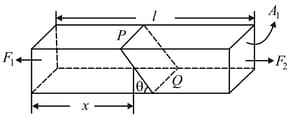B M Sharma Solutions for Chapter: Elasticity, Exercise 1: CONCEPT APPLICATION EXERCISE
B M Sharma Physics Solutions for Exercise - B M Sharma Solutions for Chapter: Elasticity, Exercise 1: CONCEPT APPLICATION EXERCISE
Attempt the practice questions on Chapter 7: Elasticity, Exercise 1: CONCEPT APPLICATION EXERCISE with hints and solutions to strengthen your understanding. Physics For Joint Entrance Examination JEE (Advanced): Mechanics II solutions are prepared by Experienced Embibe Experts.
Questions from B M Sharma Solutions for Chapter: Elasticity, Exercise 1: CONCEPT APPLICATION EXERCISE with Hints & Solutions
and are two wires. The radius of is twice that of . They are stretched by the same load. Then the stress on is
A cube of aluminium of sides is subjected to a shearing force of . The top face of the cube is displaced through with respect to the bottom face. The shearing strain would be
A steel wire can support a maximum load of before reaching its elastic limit how much load can another wire, made out of identical steel, but with a radius one half the radius of the first wire, support before reaching its elastic limit?
The maximum load a wire can withstand without breaking, when its length is reduced to half of its original length, will
The dimensions of four wires of the same material are given below. In which wire the increase in length will be maximum when the same tension is applied?
(i) Estimate the force with which a karate master strike a board, assuming the hand’s speed at the moment of impact is 10.0 m , decreasing to during a time internal of contact between the hand and the board. The mass of his hand and arm is .
(ii) Estimate the shear, assuming this force it exerted on a thick pine board that is wide.
(iii) If the maximum shear stress that a pine board can support before breaking is , will the board break?
The diameter of a brass rod is 4 mm having young’s modulus . Find the force required to stretch the rod by of its length.
A rod pulled with forces and at its ends. Find the:

(i) Tension at a distance from left and at the rod,
(ii) longitudinal and shearing stresses at the given cross-section if the cross-section of the rod is ,
(iii) conditions for maximum longitudinal and shearing stresses at the given cross-section .
